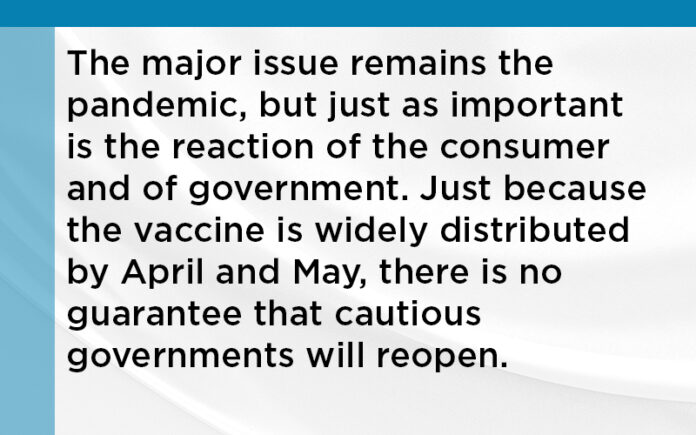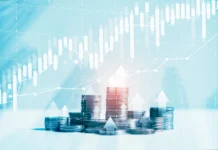by Chris Kuehl, managing director, Armada Corporate Intelligence
Yogi Berra’s wise words resonate more these days than ever. We are in a topsy-turvy world: The pandemic has devastated part of the economy but not other parts. The service sector has been slammed with the worst recession seen since the 1930s, while much of the rest of the economy has carried on as before. Housing is strong, manufacturing is mostly back to normal, exports and imports are at their usual levels, and so on. To add to the litany of business challenges, there has been the most contentious election in decades and the most chaotic transition in over a century. The result is a somewhat flummoxed business community – unsure of what to expect now. To the rescue comes the economist – famed for our ability to predict the past! There are three scenarios in play right now as far as the melding of economics and politics.
Scenario 1: For the optimist
The first scenario has the support of 25% of analysts. This asserts there will be three important developments between now and the middle of the year. The first and most likely is that vaccine distribution will reach acceptable levels by the start of the summer. There still is debate over what herd immunity will require, but it is thought to be defined by at least 240 million immunized people in the US.
Once that level is reached, the load on hospitals will decline and lockdowns will start to lift, allowing a service sector recovery. This is the second assumption – a grand reopening of the sector where consumers once spent the majority of their disposable income. This has been referred to as the “great divergence,” as consumers will switch from buying stuff to buying services again. The third development will be a resumption of some normal working patterns. People still will be working at home to a degree, but many will be back to their offices and workplaces. That has significant implications for the oil sector and thus for plastics. Oil demand will be up, and it is likely to exceed supply for a while – and that spells inflation to a degree. Prices that had been between $40 and $50 a barrel will creep up to between $60 and perhaps $80, at least for a while. That also will mean higher prices for the raw materials in plastic.
Scenario 2: For the realist
The second scenario essentially twins with the first. It also assumes there will be progress as far as vaccine distribution and the subsequent economic recovery, but there are additional issues that will have an impact on the economy. The most important will be the influence of politics. The Biden administration has a typically long list of changes and actions it wants to work on (as always takes place when there is a change in leadership). Which of these policy directions actually will emerge this year? One result of the dead tie in the Senate is the emergence of the centrists as power brokers. Nothing of real consequence will pass without their support, and that means paying close attention to four centrist Republicans (Mitt Romney, Susan Collins, Lisa Murkowski and Ben Sasse) and three centrist Democrats (Joe Manchin, Jon Tester and Kyrsten Sinema). This group likely will temper big tax hikes and big projects such as the Green New Deal or Medicare for All. Look for tweaks and alterations as opposed to big shifts.
There has been a sense thus far that Biden favors incentives over restrictions and penalties. This means encouraging the development of alternative energy as opposed to attacking fossil fuel use head-on. It means focusing trade relations on export promotion as compared to restricting imports. This scenario is attracting about 50% support from economists and underpins the assumption that growth will be between 4.0% and 5.0% by the end of the year.
Scenario 3: For the pessimist
There always has to be a negative scenario as well. Roughly 25% of analysts still assert that everything will not develop as expected and the 2020 recession will drag on through 2021. The major issue remains the pandemic, but just as important is the reaction of the consumer and of government. Just because the vaccine is widely distributed by April and May, there is no guarantee that cautious governments will reopen. It could be the end of the year before many states and cities allow restrictions to lift. Then there is the willingness of consumers to pick up where they left off. Will people go back to the restaurants and bars, attend events, be willing to go back to the office and travel for business? Many will, but is that enough? There are three hurdles for the economy to clear: 1) acceptance of the vaccine, 2) acceptance by government sufficient to reduce the restrictions and 3) acceptance by consumers sufficient to resume old patterns.
What’s next?
The data thus far supports the notion that enough people ultimately will accept the vaccine for herd immunity to occur. In December of last year, the polls suggested that around 30% were unwilling to take the vaccine, but that number now is less than 15%, as there have been few reports of bad reactions to the drug. The reduction of pandemic protocols is another story altogether. Thus far there has not been much reduction of restrictions as the pandemic numbers have not changed. The death toll still is rising, hospitals still are over capacity in many areas and the number of positive cases continues to climb. There have been few states or cities that have ventured a timeline to trigger relaxation of restrictions. It is assumed that more controlled situations will reopen first – restaurants and retail. Events and anything that draws crowds of strangers will be the last. The optimists think there will be openings by late spring, and the pessimists assert it is more likely to be late summer.
The final wild card is the consumer. Have the new ways of doing things taken hold? Will people want to go back to the office? Will they want to shop in the brick-and-mortar shop again or has the online option taken over? These are questions that can’t be answered adequately at this point.
On top of all the scenarios that are rooted in the pandemic response, there will be discussions regarding what the US political situation will mean for the economy. Trump now has departed, and attention is focused on the man who replaced him. Interestingly enough, there is not a great deal known about the plans and strategy that will emerge now. The most significant clue thus far is that Biden has surrounded himself with political veterans and people who worked with him in the Obama years.
For the plastics industry as a whole, there will be pressure to be part of the solution on issues such as climate change, solid waste and other green initiatives. The industry has been a target on these “green” concerns, but the use of plastics is ubiquitous. The push will be toward finding compromises in terms of design and usage. There will be threats and opportunities as the agenda on these issues develop. Thus far, the Biden approach has been oriented toward incentives as opposed to outright regulatory bans, but the latter tactic likely will be employed as well.
Chris Kuehl is managing director of Armada Corporate Intelligence. Armada executives function as trusted strategic advisers to business executives, merging fundamental roots in corporate intelligence gathering, economic forecasting and strategy development. Armada focuses on the market forces bearing down on organizations.
More information: www.armada-intel.com





